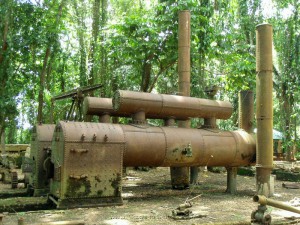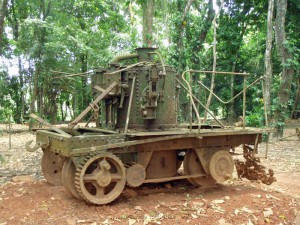The cultivation of sugar cane was introduced to Belize by the Maya and Mestizo refugees who fled from Mexico’s Yucatan Peninsula as a result of the 1848 Guerra de Las Castas. During and after the American Civil War (1861-1865), Americans living in the Southern United States migrated to Belize. These immigrants settled initially in the Cowpen area of the Toledo District then migrated to different areas, primarily in southern Belize investing large amounts of capital in sugar estates. During the 18th century and early 19th century numerous small sugar mills were established throughout southern Belize.
Two steam powered mills owned by the Serpon and Regalia Sugar Estates were established in 1863 marking the arrival of the industrial era to Belize. The Regalia Estate was initially managed by Mr. de Brame for the owner Mr. Antonio Mathe. Between 1868 and 1874 the Regalia Mill was owned by Young, Toledo and Company after the suicide of Mr. Antonio Mathe and managed by Mr. Samuel McCutchon, a Confederate, of St. Charles Parish, Louisiana, USA. Regalia Estate later changed management and ownership in 1882 when Mr. Reginald Ross, an experience Demerara planter, was named manager for the new owner Mr. Bernard Cramer. The Serpon Estate was, however, managed by its owner Mr. Bowman, a native of Scotland.
By the turn of the century sugar production was found to be more profitable in the Corozal and Orange Walk Districts, and the Serpon and Regalia mills were eventually abandoned 1910.
The Main Crusher
This main crusher is still very much on its original foundation. It is a late three wheel crusher known as a six-oiler, referring to the fact that there are six main bearings in the crusher. The main crusher is complimented by a large flywheel and a horizontal mill engine manufactured by D. Stewart and Company Glasgow.
The Boiler
Steam was the power of the day at the Serpon Sugar Mill and the tremendous amount of steam needed to run this operation was generated by two ‘sill-mounted locomotive style boilers’ with dry open bottoms. These English style boilers were fully assembled at the factory and then shipped to the site. Once erected on the brick sills these boilers were ready to be fired.
Beam Engine
This engine is a slow speed single eccentric beam engine dating to probably 1840 to 1850, of English manufacture. It has a unique vertical cylinder that operated totally different from the other engines on the site. Under the beam gantry is the remainder of a typical ‘Two-ball, Governor’.
Evaporating Furnace
The evaporating section consisted of a seventy five feet long brick furnace that is characterized by a series of arches throughout the structure. The front of the furnace has a firing arch similar to a boiler’s firebox.
Hot Air Exchanger
The hot air heat exchanger is located at the far end of the furnace and functions as an exhaust for the heat travelling down the length of the furnace as well as a supplier of hot air for the sugar dryer. The sugar dryer sits adjacent to the hot air exchanger on a rectangular brick base.
The Locomotive
The small locomotive is quite complete and typical of the type of locomotive used in the cane industry, the logging industry and dockside work around this time period. This locomotive was powered at one end by a two-cylinder compound steam engine that drove one axle which in turn drove the other, making the locomotive a four wheel drive.
The Tredegar Engine
This small engine was manufactured by Tredegar Iron Works; an early American iron works company that built steam engines. The main function of the Tredegar Engine was to pump the huge volume of water from the river that was required to run the everyday operation of the mill.
Source: BelizeMaya 2012



